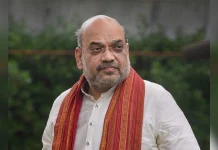Unabated poaching of Assam’s one-horned rhino–the state’s proud icon–became a hot-button election issue in 2016 with the BJP promising to crack down on poachers and eliminate the racket. Both Prime Minister Narendra Modi and Union Home Minister Amit Shah, in the course of the election campaign six years ago, accused the Congress of being hand-in-glove with poachers and promised to curb wildlife poaching once the BJP comes to power in the state.
By Jaideep Mazumdar
In the 15 years of Congress rule in the state since the turn of the century, Assam had seen the killings of a record 171 rhinos by poachers for the horn of the animal. The horn, which is falsely rumoured to have aphrodisiac properties, is in very high demand in China and some other countries.
The BJP has been true to its word and from a high of 27 each in 2013 and 2014, incidents of poaching came down to just six within a year of the party coming to power in the northeastern state that is the last refuge of the one-horned rhino in the world.
And last year (2021), just one rhino was killed by poachers in Assam at the state’s famed Kaziranga National Park. The last time the state recorded such a low casualty was 45 years ago, in 1976! And, before that, in 1962 and 1963 also, the (rhino) death toll was also just one.
It was only in 1972 and 1977 that Assam recorded zero rhino poaching. Since 1962, when a count of poaching incidents was started, an estimated 1169 rhinos have been killed in Assam. In the 1960s, two years–1965 and 1967–stood out as bad years for the rhinos with 18 and 12 rhinos killed respectively by poachers in those two years.
But poaching of rhinos, and other wildlife as well–tigers for their teeth, claws and skin, deer for their meat, and elephants for ivory–shot up from 1980 and peaked in 1983 when 92 rhinos were killed by poachers. This increase coincided with the start of the massive agitation (from 1979 to 1986) in Assam against unabated and illegal influx of Bangladeshis into the state.
It was only from the mid-1990s, when conservation and anti-poaching measures were strengthened, that the death toll started falling. But poaching increased during the last years of Congress rule in the state (the middle part of the last decade) due to a general deterioration of the law and order situation in the state and alleged collusion between senior Congress leaders and poachers.
What led to rise in poaching:
According to Assam forest department officers, two primary factors led to a spike in poaching from the mid-1980s. One was the formation of poaching rings with sharpshooters from Nagaland and the North Cachar Hills of Assam being the kingpins.
“The rise in income levels in China from the mid-1980s led to a sharp increase in the demand for rhino horns which, the Chinese erroneously believe, has aphrodisiac and medicinal properties. Naga militants (who already had links with China) were recruited by the Chinese cartels and they became the poachers or recruited sharpshooters to travel to Assam to hunt rhinos. The Nagas also recruited people from the hills of Assam who possess a good idea of the terrain of the three rhino sanctuaries–the Kaziranga National Park, Laokhowa-Burachapori Wildlife Sanctuary and the Pobitora National Park–as sharpshooters and helpers,” said retired forest officer Simanta Talukdar.
Talukdar, who was closely involved in the framing of conservation and anti-poaching tactics after the BJP came to power in the state, retired from service last year. The other factor that aided the poaching of rhinos and other wildlife was the presence of Bangladesh-origin Muslim encroachers in the buffer zones and even core areas of the three sanctuaries.
In pursuit of its vote bank politics and sacrificing the interests of the state, the Congress encouraged more and more Bangladesh-origin Muslims to encroach into these wildlife habitats and settle down there. These encroachers became helpers and scouts for the poachers.
Yet another factor was the patronage that the poachers reportedly received from some Congress politicians. “At least one senior Congress leader who was also a minister had clear and strong links with the poaching gangs and used to patronize and protect them. That’s why the police and forest officials were wary of taking action against poachers,” said Talukdar.
What the BJP did after coming to power:
In keeping with its promise of curbing the killing of rhinos, the BJP government in Assam declared a war on poachers as soon as it assumed office. It publicly announced a ‘zero-tolerance’ policy against poachers and warned that poachers would be dealt with without any mercy.
The state’s law enforcement machinery started cracking down on poaching rings. Some poachers and traders involved in smuggling out rhino horns and other viscera of wildlife were apprehended and slapped with stiff charges.
Vigil was also stepped up within and around the rhino sanctuaries and a few poachers were also killed in shootouts with police and forest guards. The chilling message went out to poachers and wildlife trafficking rings that poaching would no longer be tolerated.
At the same time, the BJP government initiated anti-encroachment drives in the three sanctuaries to evict encroachers, most of them Bangladesh-origin Muslims. Despite protests from human rights and other organisations who covertly protect illegal infiltrators, the state government intensified the eviction drives and removed encroachments from vast tracts of forests.
Simultaneously, indigenous people living in the periphery of wildlife parks and sanctuaries were brought in the cover of various welfare and livelihood-enhancement schemes. “The indigenous people living around the wildlife parks and sanctuaries have become ardent wildlife protectors and now form our first line of defence against poachers,” Assam forest minister Parimal Suklabaidya told Swarajya from state capital Guwahati.
The process of co-opting indigenous people living around wildlife parks and sanctuaries in the government’s conservation efforts was initiated by Suklabaidya’s predecessor, Pramila Rani Brahma. Brahma was the forest minister in the Sarbananda Sonowal government from 2016.
“We got the local and indigenous people involved in conservation and made them realise that it was in their interests to help conserve wildlife. We incentivised this and the locals developed a stake in conservation. At the same time, we hit the poaching rings very hard and many poachers were arrested or killed,” said Brahma.
Suklabaidya said that last year, a dedicated force named the ‘Special Rhino Protection Force’ (read this) was raised exclusively for protecting rhinos. This force, which started off with 82 men and women specially trained in anti-poaching and conservation tactics, is under the direct supervision of Assam’s special DGP (Law & Order), GP Singh.
“The presence of this force has acted as a powerful deterrent against poachers, who have got the unequivocal message that the Assam government means business and poaching will not be tolerated at all and poachers will be dealt with very harshly,” said Singh.
All these efforts have borne fruit and in 2021, just one rhino fell prey to poachers. Forest Minister Suklabaidya said that all-out efforts are being made to bring down this number to zero this year.
“We are committed to eliminating poaching altogether. We want to make Assam a poaching-free state. Poaching will not be tolerated at all,” he said.
An emotive issue for Assam
The protection of the rhino became an emotive issue for the people of Assam since the days of the Assam movement when the demand for protecting the rhino was first raised. The one-horned rhino became the pride of the state and popular Bihu songs, literature, cinema and popular art made the rhino synonymous with Assam and Assamese identity.
The issue entered the political narrative when poaching was linked to the loss of control of indigenous communities over land and resources due to the illegal influx of immigrants from Bangladesh.
Today, in Assam, a decrease in the number of rhinos killed by poachers is interpreted as an indication of good governance and improvement in the law and order situation. “If poaching is curbed, it is seen as the government having a firm grip on the state and being successful in curbing crime,” said a retired police ADG.
This article first appeared in www.swarajyamag.com and it belongs to them.












